ACC210 - Financial Accounting Task 2 Assignment, Semester 2, 2017
VerifiedAdded on 2020/04/01
|14
|2314
|34
Homework Assignment
AI Summary
This assignment solution for ACC210 Financial Accounting Task 2 addresses several key concepts in financial accounting. It begins with a detailed analysis of fair value measurement, including determining the subject of measurement, valuation premises, market determination, and valuation techniques. The solution then provides comprehensive calculations and general journal entries for the periods from 1/7/16 to 30/6/17, 1/8/18, and 30/6/18, including depreciation, revaluation, and impairment loss calculations, supported by working notes. The assignment also explores accounting issues related to internally generated versus acquired intangible assets, discussing the differences and reasons for reluctance in applying relevant accounting standards. Finally, it covers the deficit of funds, net defined benefit liability, and net interest calculations, including journal entries and a reconciliation of defined benefit obligations and plan assets. The solution is supported by a list of references including books, journals and online resources.
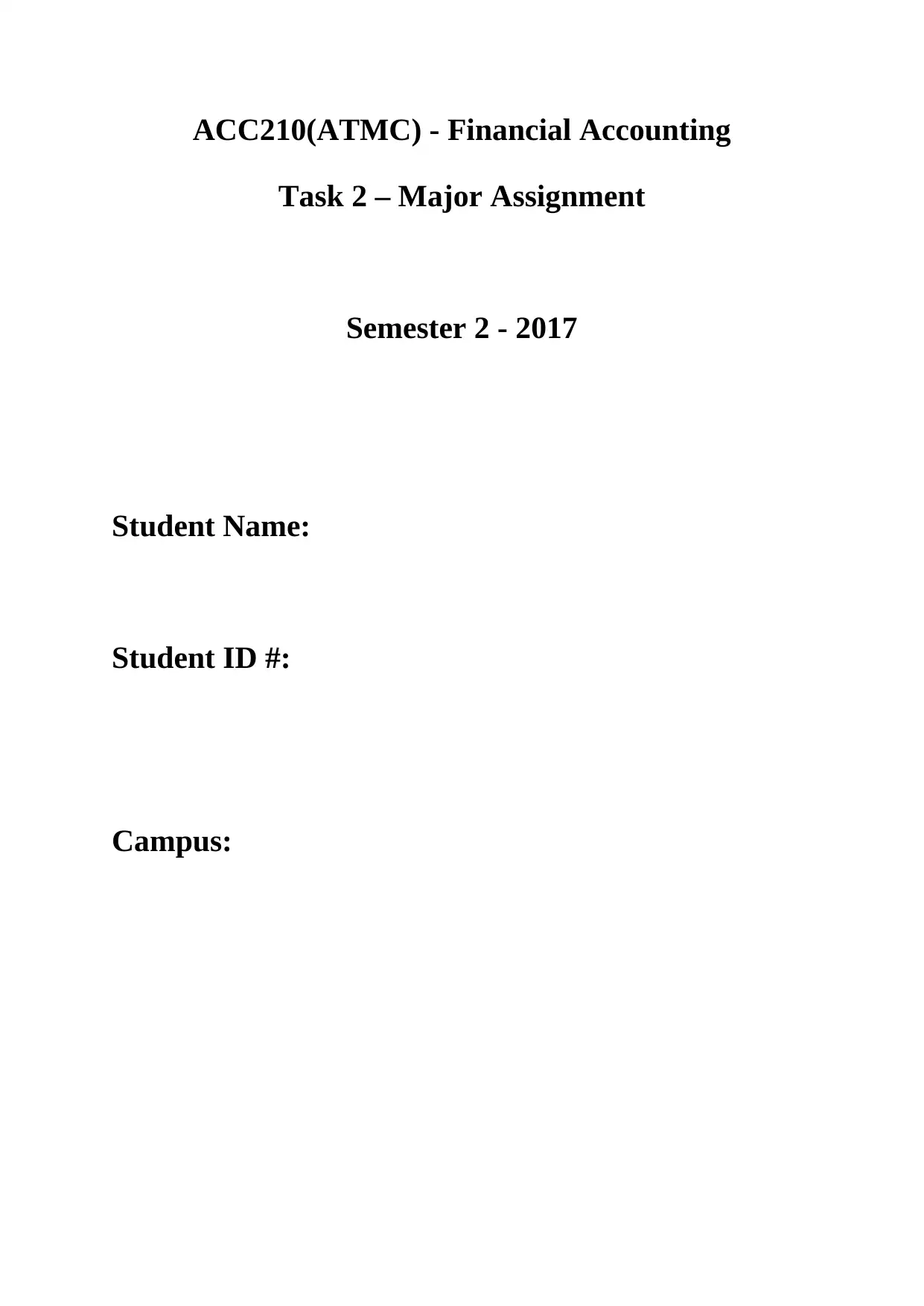
ACC210(ATMC) - Financial Accounting
Task 2 – Major Assignment
Semester 2 - 2017
Student Name:
Student ID #:
Campus:
Task 2 – Major Assignment
Semester 2 - 2017
Student Name:
Student ID #:
Campus:
Paraphrase This Document
Need a fresh take? Get an instant paraphrase of this document with our AI Paraphraser
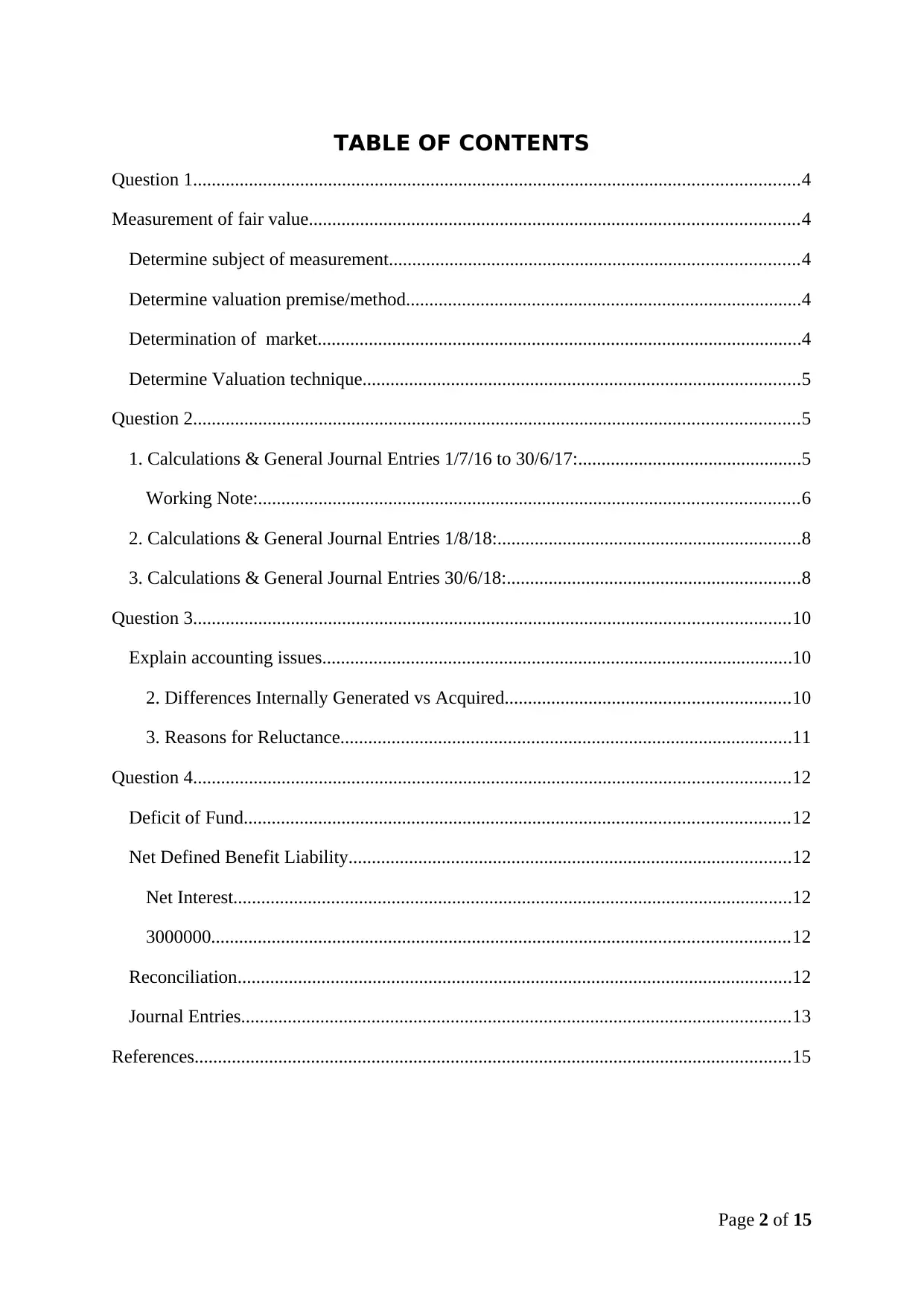
TABLE OF CONTENTS
Question 1..................................................................................................................................4
Measurement of fair value.........................................................................................................4
Determine subject of measurement........................................................................................4
Determine valuation premise/method.....................................................................................4
Determination of market........................................................................................................4
Determine Valuation technique..............................................................................................5
Question 2..................................................................................................................................5
1. Calculations & General Journal Entries 1/7/16 to 30/6/17:................................................5
Working Note:....................................................................................................................6
2. Calculations & General Journal Entries 1/8/18:.................................................................8
3. Calculations & General Journal Entries 30/6/18:...............................................................8
Question 3................................................................................................................................10
Explain accounting issues.....................................................................................................10
2. Differences Internally Generated vs Acquired.............................................................10
3. Reasons for Reluctance.................................................................................................11
Question 4................................................................................................................................12
Deficit of Fund.....................................................................................................................12
Net Defined Benefit Liability...............................................................................................12
Net Interest........................................................................................................................12
3000000............................................................................................................................12
Reconciliation.......................................................................................................................12
Journal Entries......................................................................................................................13
References................................................................................................................................15
Page 2 of 15
Question 1..................................................................................................................................4
Measurement of fair value.........................................................................................................4
Determine subject of measurement........................................................................................4
Determine valuation premise/method.....................................................................................4
Determination of market........................................................................................................4
Determine Valuation technique..............................................................................................5
Question 2..................................................................................................................................5
1. Calculations & General Journal Entries 1/7/16 to 30/6/17:................................................5
Working Note:....................................................................................................................6
2. Calculations & General Journal Entries 1/8/18:.................................................................8
3. Calculations & General Journal Entries 30/6/18:...............................................................8
Question 3................................................................................................................................10
Explain accounting issues.....................................................................................................10
2. Differences Internally Generated vs Acquired.............................................................10
3. Reasons for Reluctance.................................................................................................11
Question 4................................................................................................................................12
Deficit of Fund.....................................................................................................................12
Net Defined Benefit Liability...............................................................................................12
Net Interest........................................................................................................................12
3000000............................................................................................................................12
Reconciliation.......................................................................................................................12
Journal Entries......................................................................................................................13
References................................................................................................................................15
Page 2 of 15
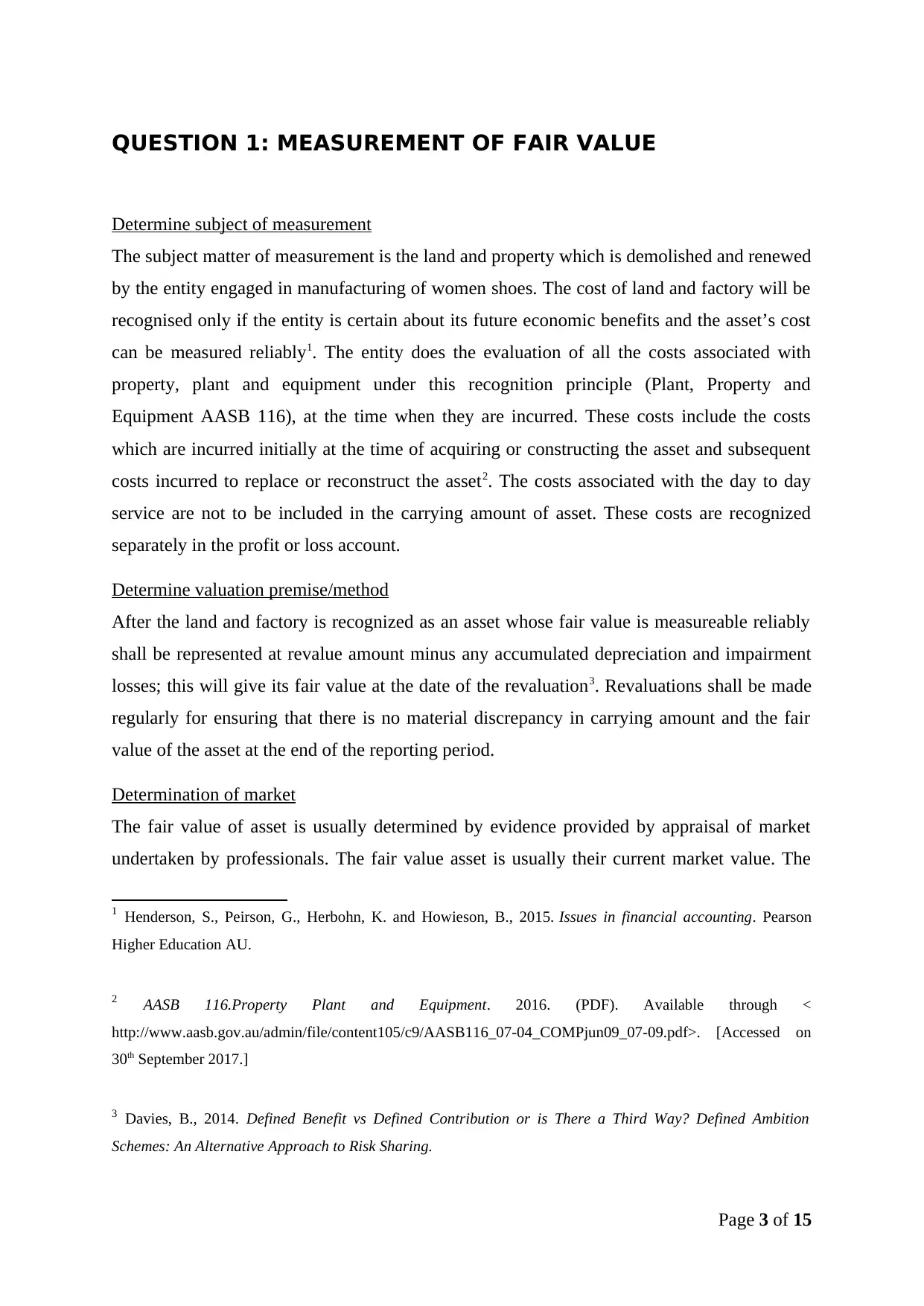
QUESTION 1: MEASUREMENT OF FAIR VALUE
Determine subject of measurement
The subject matter of measurement is the land and property which is demolished and renewed
by the entity engaged in manufacturing of women shoes. The cost of land and factory will be
recognised only if the entity is certain about its future economic benefits and the asset’s cost
can be measured reliably1. The entity does the evaluation of all the costs associated with
property, plant and equipment under this recognition principle (Plant, Property and
Equipment AASB 116), at the time when they are incurred. These costs include the costs
which are incurred initially at the time of acquiring or constructing the asset and subsequent
costs incurred to replace or reconstruct the asset2. The costs associated with the day to day
service are not to be included in the carrying amount of asset. These costs are recognized
separately in the profit or loss account.
Determine valuation premise/method
After the land and factory is recognized as an asset whose fair value is measureable reliably
shall be represented at revalue amount minus any accumulated depreciation and impairment
losses; this will give its fair value at the date of the revaluation3. Revaluations shall be made
regularly for ensuring that there is no material discrepancy in carrying amount and the fair
value of the asset at the end of the reporting period.
Determination of market
The fair value of asset is usually determined by evidence provided by appraisal of market
undertaken by professionals. The fair value asset is usually their current market value. The
1 Henderson, S., Peirson, G., Herbohn, K. and Howieson, B., 2015. Issues in financial accounting. Pearson
Higher Education AU.
2 AASB 116.Property Plant and Equipment. 2016. (PDF). Available through <
http://www.aasb.gov.au/admin/file/content105/c9/AASB116_07-04_COMPjun09_07-09.pdf>. [Accessed on
30th September 2017.]
3 Davies, B., 2014. Defined Benefit vs Defined Contribution or is There a Third Way? Defined Ambition
Schemes: An Alternative Approach to Risk Sharing.
Page 3 of 15
Determine subject of measurement
The subject matter of measurement is the land and property which is demolished and renewed
by the entity engaged in manufacturing of women shoes. The cost of land and factory will be
recognised only if the entity is certain about its future economic benefits and the asset’s cost
can be measured reliably1. The entity does the evaluation of all the costs associated with
property, plant and equipment under this recognition principle (Plant, Property and
Equipment AASB 116), at the time when they are incurred. These costs include the costs
which are incurred initially at the time of acquiring or constructing the asset and subsequent
costs incurred to replace or reconstruct the asset2. The costs associated with the day to day
service are not to be included in the carrying amount of asset. These costs are recognized
separately in the profit or loss account.
Determine valuation premise/method
After the land and factory is recognized as an asset whose fair value is measureable reliably
shall be represented at revalue amount minus any accumulated depreciation and impairment
losses; this will give its fair value at the date of the revaluation3. Revaluations shall be made
regularly for ensuring that there is no material discrepancy in carrying amount and the fair
value of the asset at the end of the reporting period.
Determination of market
The fair value of asset is usually determined by evidence provided by appraisal of market
undertaken by professionals. The fair value asset is usually their current market value. The
1 Henderson, S., Peirson, G., Herbohn, K. and Howieson, B., 2015. Issues in financial accounting. Pearson
Higher Education AU.
2 AASB 116.Property Plant and Equipment. 2016. (PDF). Available through <
http://www.aasb.gov.au/admin/file/content105/c9/AASB116_07-04_COMPjun09_07-09.pdf>. [Accessed on
30th September 2017.]
3 Davies, B., 2014. Defined Benefit vs Defined Contribution or is There a Third Way? Defined Ambition
Schemes: An Alternative Approach to Risk Sharing.
Page 3 of 15
⊘ This is a preview!⊘
Do you want full access?
Subscribe today to unlock all pages.

Trusted by 1+ million students worldwide

entity must allocates the initial amount of the non-current tangible assets to its significant
parts and apply depreciation to each part separately. On the other hand if the entity acquires
the physical asset on lease basis, it is appropriate to depreciate the asset separately. The
disclosure required by standard requires reflecting the following-
The existence of any title on the property, plant and equipment pledged as
security and their respective amounts4;
The amount of expenditures which are being recognised in the carrying
amount of property, plant and equipment in its construction phase;
the amount of contractual obligations which are to be paid for the acquisition
of the assets5;
If the impairment is not disclosed separately in the comprehensive income
statement, that is included in profit or loss account in total.
Determine Valuation technique
As per the valuation technique provided by IAS 116, the valuation of land will be done in the
following manner-
Market value of land+ demolishing cost+ cost of construction
10, 000, 00+ 10, 000, 00+780000= 27, 80,000
QUESTION 2
Calculations & General Journal Entries 1/7/16 to 30/6/17:
(Amount in $)
Date Account DR CR
1-07-2016 Machine A/c DR. 100000
Bank A/C Cr. 100000
(Being machine A purchased)
4 Ji, X.D. and Lu, W., 2014. The value relevance and reliability of intangible assets: Evidence from Australia
before and after adopting IFRS. Asian Review of Accounting, 22(3), pp.182-216.
5 Basu, A. and Andrews, S., 2014. Asset allocation policy, returns and expenses of superannuation funds: recent
evidence based on default options. Australian Economic Review, 47(1), pp.63-77.
Page 4 of 15
parts and apply depreciation to each part separately. On the other hand if the entity acquires
the physical asset on lease basis, it is appropriate to depreciate the asset separately. The
disclosure required by standard requires reflecting the following-
The existence of any title on the property, plant and equipment pledged as
security and their respective amounts4;
The amount of expenditures which are being recognised in the carrying
amount of property, plant and equipment in its construction phase;
the amount of contractual obligations which are to be paid for the acquisition
of the assets5;
If the impairment is not disclosed separately in the comprehensive income
statement, that is included in profit or loss account in total.
Determine Valuation technique
As per the valuation technique provided by IAS 116, the valuation of land will be done in the
following manner-
Market value of land+ demolishing cost+ cost of construction
10, 000, 00+ 10, 000, 00+780000= 27, 80,000
QUESTION 2
Calculations & General Journal Entries 1/7/16 to 30/6/17:
(Amount in $)
Date Account DR CR
1-07-2016 Machine A/c DR. 100000
Bank A/C Cr. 100000
(Being machine A purchased)
4 Ji, X.D. and Lu, W., 2014. The value relevance and reliability of intangible assets: Evidence from Australia
before and after adopting IFRS. Asian Review of Accounting, 22(3), pp.182-216.
5 Basu, A. and Andrews, S., 2014. Asset allocation policy, returns and expenses of superannuation funds: recent
evidence based on default options. Australian Economic Review, 47(1), pp.63-77.
Page 4 of 15
Paraphrase This Document
Need a fresh take? Get an instant paraphrase of this document with our AI Paraphraser
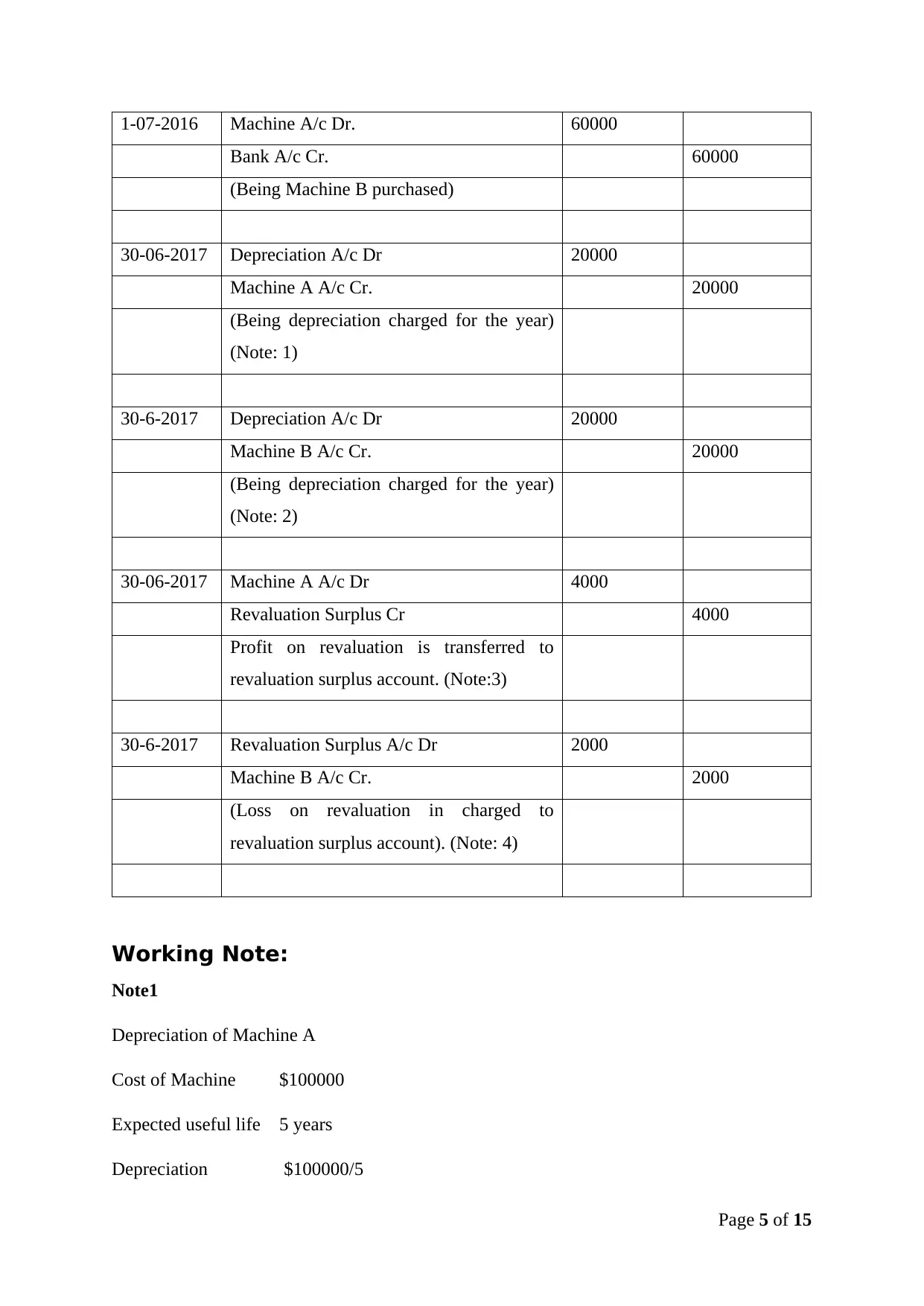
1-07-2016 Machine A/c Dr. 60000
Bank A/c Cr. 60000
(Being Machine B purchased)
30-06-2017 Depreciation A/c Dr 20000
Machine A A/c Cr. 20000
(Being depreciation charged for the year)
(Note: 1)
30-6-2017 Depreciation A/c Dr 20000
Machine B A/c Cr. 20000
(Being depreciation charged for the year)
(Note: 2)
30-06-2017 Machine A A/c Dr 4000
Revaluation Surplus Cr 4000
Profit on revaluation is transferred to
revaluation surplus account. (Note:3)
30-6-2017 Revaluation Surplus A/c Dr 2000
Machine B A/c Cr. 2000
(Loss on revaluation in charged to
revaluation surplus account). (Note: 4)
Working Note:
Note1
Depreciation of Machine A
Cost of Machine $100000
Expected useful life 5 years
Depreciation $100000/5
Page 5 of 15
Bank A/c Cr. 60000
(Being Machine B purchased)
30-06-2017 Depreciation A/c Dr 20000
Machine A A/c Cr. 20000
(Being depreciation charged for the year)
(Note: 1)
30-6-2017 Depreciation A/c Dr 20000
Machine B A/c Cr. 20000
(Being depreciation charged for the year)
(Note: 2)
30-06-2017 Machine A A/c Dr 4000
Revaluation Surplus Cr 4000
Profit on revaluation is transferred to
revaluation surplus account. (Note:3)
30-6-2017 Revaluation Surplus A/c Dr 2000
Machine B A/c Cr. 2000
(Loss on revaluation in charged to
revaluation surplus account). (Note: 4)
Working Note:
Note1
Depreciation of Machine A
Cost of Machine $100000
Expected useful life 5 years
Depreciation $100000/5
Page 5 of 15

$20000 p.a.
Note2
Depreciation of Machine B
Cost of Machine $60000
Expected useful life 3 years
Depreciation $60000/3
$20000 p.a.
Note 3
Revaluation Surplus on Machine A
Fair value of Machine A on 30th June 2017
= $84000
Book Value of Machine A on 30th June 2017
=$100000-$20000
=$80000
Revaluation Surplus of Machine A
Fair Value – Book Value
$84000- $80000
$4000
Note 4
Impairment loss on Machine B
Fair value of Machine B on 30th June 2017
= $38000
Book Value of Machine B on 30th June 2017
Page 6 of 15
Note2
Depreciation of Machine B
Cost of Machine $60000
Expected useful life 3 years
Depreciation $60000/3
$20000 p.a.
Note 3
Revaluation Surplus on Machine A
Fair value of Machine A on 30th June 2017
= $84000
Book Value of Machine A on 30th June 2017
=$100000-$20000
=$80000
Revaluation Surplus of Machine A
Fair Value – Book Value
$84000- $80000
$4000
Note 4
Impairment loss on Machine B
Fair value of Machine B on 30th June 2017
= $38000
Book Value of Machine B on 30th June 2017
Page 6 of 15
⊘ This is a preview!⊘
Do you want full access?
Subscribe today to unlock all pages.

Trusted by 1+ million students worldwide
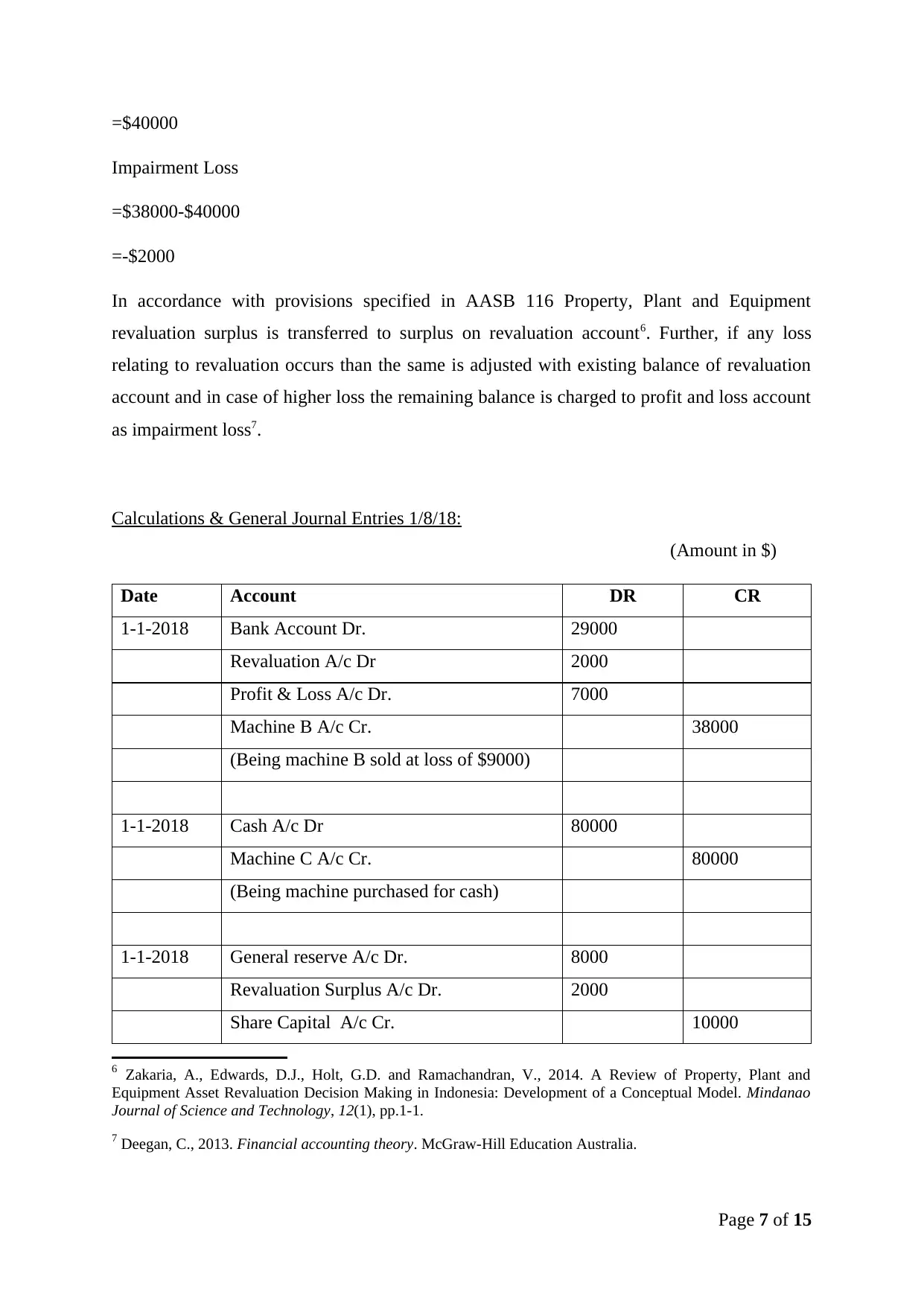
=$40000
Impairment Loss
=$38000-$40000
=-$2000
In accordance with provisions specified in AASB 116 Property, Plant and Equipment
revaluation surplus is transferred to surplus on revaluation account6. Further, if any loss
relating to revaluation occurs than the same is adjusted with existing balance of revaluation
account and in case of higher loss the remaining balance is charged to profit and loss account
as impairment loss7.
Calculations & General Journal Entries 1/8/18:
(Amount in $)
Date Account DR CR
1-1-2018 Bank Account Dr. 29000
Revaluation A/c Dr 2000
Profit & Loss A/c Dr. 7000
Machine B A/c Cr. 38000
(Being machine B sold at loss of $9000)
1-1-2018 Cash A/c Dr 80000
Machine C A/c Cr. 80000
(Being machine purchased for cash)
1-1-2018 General reserve A/c Dr. 8000
Revaluation Surplus A/c Dr. 2000
Share Capital A/c Cr. 10000
6 Zakaria, A., Edwards, D.J., Holt, G.D. and Ramachandran, V., 2014. A Review of Property, Plant and
Equipment Asset Revaluation Decision Making in Indonesia: Development of a Conceptual Model. Mindanao
Journal of Science and Technology, 12(1), pp.1-1.
7 Deegan, C., 2013. Financial accounting theory. McGraw-Hill Education Australia.
Page 7 of 15
Impairment Loss
=$38000-$40000
=-$2000
In accordance with provisions specified in AASB 116 Property, Plant and Equipment
revaluation surplus is transferred to surplus on revaluation account6. Further, if any loss
relating to revaluation occurs than the same is adjusted with existing balance of revaluation
account and in case of higher loss the remaining balance is charged to profit and loss account
as impairment loss7.
Calculations & General Journal Entries 1/8/18:
(Amount in $)
Date Account DR CR
1-1-2018 Bank Account Dr. 29000
Revaluation A/c Dr 2000
Profit & Loss A/c Dr. 7000
Machine B A/c Cr. 38000
(Being machine B sold at loss of $9000)
1-1-2018 Cash A/c Dr 80000
Machine C A/c Cr. 80000
(Being machine purchased for cash)
1-1-2018 General reserve A/c Dr. 8000
Revaluation Surplus A/c Dr. 2000
Share Capital A/c Cr. 10000
6 Zakaria, A., Edwards, D.J., Holt, G.D. and Ramachandran, V., 2014. A Review of Property, Plant and
Equipment Asset Revaluation Decision Making in Indonesia: Development of a Conceptual Model. Mindanao
Journal of Science and Technology, 12(1), pp.1-1.
7 Deegan, C., 2013. Financial accounting theory. McGraw-Hill Education Australia.
Page 7 of 15
Paraphrase This Document
Need a fresh take? Get an instant paraphrase of this document with our AI Paraphraser
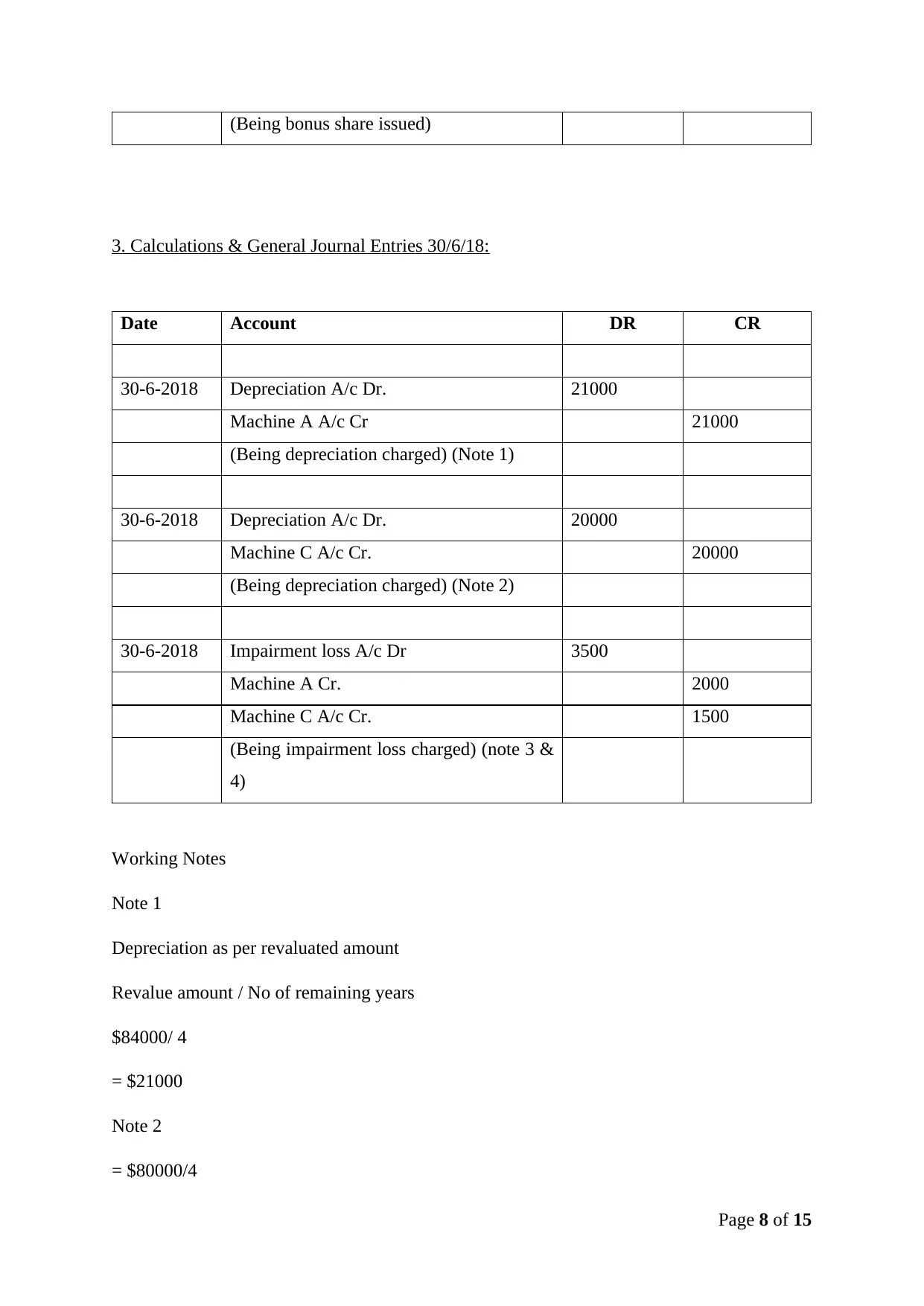
(Being bonus share issued)
3. Calculations & General Journal Entries 30/6/18:
Date Account DR CR
30-6-2018 Depreciation A/c Dr. 21000
Machine A A/c Cr 21000
(Being depreciation charged) (Note 1)
30-6-2018 Depreciation A/c Dr. 20000
Machine C A/c Cr. 20000
(Being depreciation charged) (Note 2)
30-6-2018 Impairment loss A/c Dr 3500
Machine A Cr. 2000
Machine C A/c Cr. 1500
(Being impairment loss charged) (note 3 &
4)
Working Notes
Note 1
Depreciation as per revaluated amount
Revalue amount / No of remaining years
$84000/ 4
= $21000
Note 2
= $80000/4
Page 8 of 15
3. Calculations & General Journal Entries 30/6/18:
Date Account DR CR
30-6-2018 Depreciation A/c Dr. 21000
Machine A A/c Cr 21000
(Being depreciation charged) (Note 1)
30-6-2018 Depreciation A/c Dr. 20000
Machine C A/c Cr. 20000
(Being depreciation charged) (Note 2)
30-6-2018 Impairment loss A/c Dr 3500
Machine A Cr. 2000
Machine C A/c Cr. 1500
(Being impairment loss charged) (note 3 &
4)
Working Notes
Note 1
Depreciation as per revaluated amount
Revalue amount / No of remaining years
$84000/ 4
= $21000
Note 2
= $80000/4
Page 8 of 15
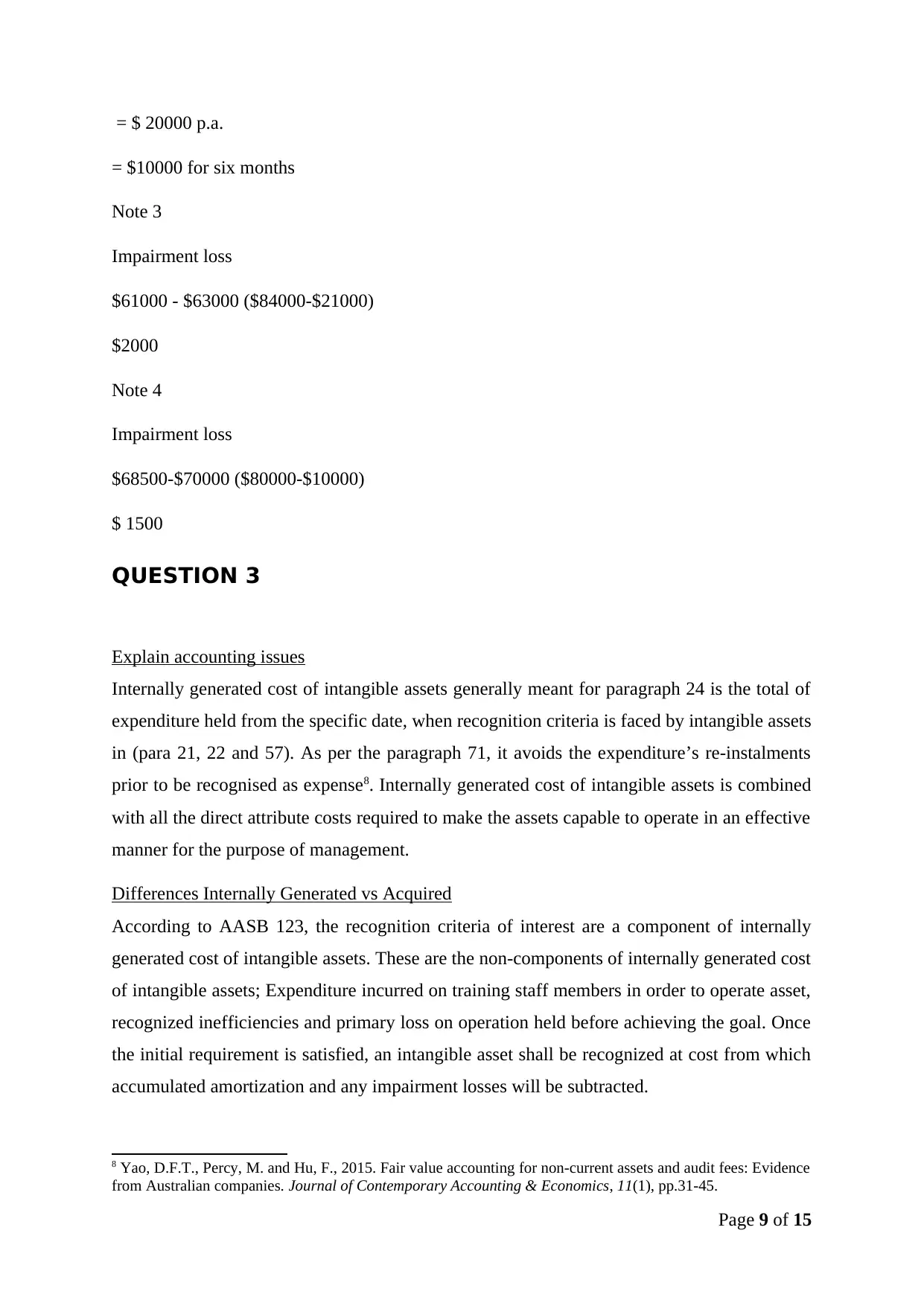
= $ 20000 p.a.
= $10000 for six months
Note 3
Impairment loss
$61000 - $63000 ($84000-$21000)
$2000
Note 4
Impairment loss
$68500-$70000 ($80000-$10000)
$ 1500
QUESTION 3
Explain accounting issues
Internally generated cost of intangible assets generally meant for paragraph 24 is the total of
expenditure held from the specific date, when recognition criteria is faced by intangible assets
in (para 21, 22 and 57). As per the paragraph 71, it avoids the expenditure’s re-instalments
prior to be recognised as expense8. Internally generated cost of intangible assets is combined
with all the direct attribute costs required to make the assets capable to operate in an effective
manner for the purpose of management.
Differences Internally Generated vs Acquired
According to AASB 123, the recognition criteria of interest are a component of internally
generated cost of intangible assets. These are the non-components of internally generated cost
of intangible assets; Expenditure incurred on training staff members in order to operate asset,
recognized inefficiencies and primary loss on operation held before achieving the goal. Once
the initial requirement is satisfied, an intangible asset shall be recognized at cost from which
accumulated amortization and any impairment losses will be subtracted.
8 Yao, D.F.T., Percy, M. and Hu, F., 2015. Fair value accounting for non-current assets and audit fees: Evidence
from Australian companies. Journal of Contemporary Accounting & Economics, 11(1), pp.31-45.
Page 9 of 15
= $10000 for six months
Note 3
Impairment loss
$61000 - $63000 ($84000-$21000)
$2000
Note 4
Impairment loss
$68500-$70000 ($80000-$10000)
$ 1500
QUESTION 3
Explain accounting issues
Internally generated cost of intangible assets generally meant for paragraph 24 is the total of
expenditure held from the specific date, when recognition criteria is faced by intangible assets
in (para 21, 22 and 57). As per the paragraph 71, it avoids the expenditure’s re-instalments
prior to be recognised as expense8. Internally generated cost of intangible assets is combined
with all the direct attribute costs required to make the assets capable to operate in an effective
manner for the purpose of management.
Differences Internally Generated vs Acquired
According to AASB 123, the recognition criteria of interest are a component of internally
generated cost of intangible assets. These are the non-components of internally generated cost
of intangible assets; Expenditure incurred on training staff members in order to operate asset,
recognized inefficiencies and primary loss on operation held before achieving the goal. Once
the initial requirement is satisfied, an intangible asset shall be recognized at cost from which
accumulated amortization and any impairment losses will be subtracted.
8 Yao, D.F.T., Percy, M. and Hu, F., 2015. Fair value accounting for non-current assets and audit fees: Evidence
from Australian companies. Journal of Contemporary Accounting & Economics, 11(1), pp.31-45.
Page 9 of 15
⊘ This is a preview!⊘
Do you want full access?
Subscribe today to unlock all pages.

Trusted by 1+ million students worldwide
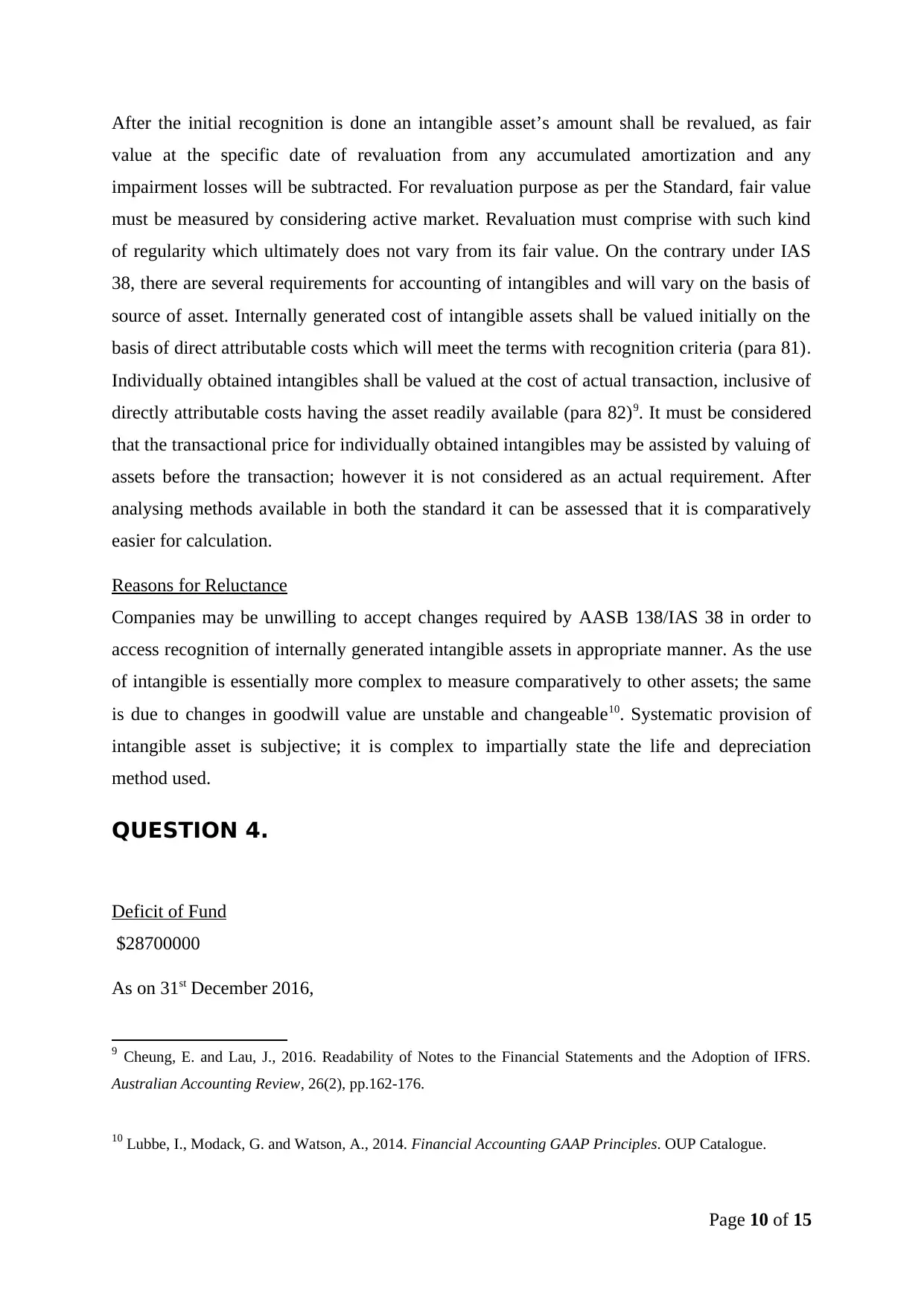
After the initial recognition is done an intangible asset’s amount shall be revalued, as fair
value at the specific date of revaluation from any accumulated amortization and any
impairment losses will be subtracted. For revaluation purpose as per the Standard, fair value
must be measured by considering active market. Revaluation must comprise with such kind
of regularity which ultimately does not vary from its fair value. On the contrary under IAS
38, there are several requirements for accounting of intangibles and will vary on the basis of
source of asset. Internally generated cost of intangible assets shall be valued initially on the
basis of direct attributable costs which will meet the terms with recognition criteria (para 81).
Individually obtained intangibles shall be valued at the cost of actual transaction, inclusive of
directly attributable costs having the asset readily available (para 82)9. It must be considered
that the transactional price for individually obtained intangibles may be assisted by valuing of
assets before the transaction; however it is not considered as an actual requirement. After
analysing methods available in both the standard it can be assessed that it is comparatively
easier for calculation.
Reasons for Reluctance
Companies may be unwilling to accept changes required by AASB 138/IAS 38 in order to
access recognition of internally generated intangible assets in appropriate manner. As the use
of intangible is essentially more complex to measure comparatively to other assets; the same
is due to changes in goodwill value are unstable and changeable10. Systematic provision of
intangible asset is subjective; it is complex to impartially state the life and depreciation
method used.
QUESTION 4.
Deficit of Fund
$28700000
As on 31st December 2016,
9 Cheung, E. and Lau, J., 2016. Readability of Notes to the Financial Statements and the Adoption of IFRS.
Australian Accounting Review, 26(2), pp.162-176.
10 Lubbe, I., Modack, G. and Watson, A., 2014. Financial Accounting GAAP Principles. OUP Catalogue.
Page 10 of 15
value at the specific date of revaluation from any accumulated amortization and any
impairment losses will be subtracted. For revaluation purpose as per the Standard, fair value
must be measured by considering active market. Revaluation must comprise with such kind
of regularity which ultimately does not vary from its fair value. On the contrary under IAS
38, there are several requirements for accounting of intangibles and will vary on the basis of
source of asset. Internally generated cost of intangible assets shall be valued initially on the
basis of direct attributable costs which will meet the terms with recognition criteria (para 81).
Individually obtained intangibles shall be valued at the cost of actual transaction, inclusive of
directly attributable costs having the asset readily available (para 82)9. It must be considered
that the transactional price for individually obtained intangibles may be assisted by valuing of
assets before the transaction; however it is not considered as an actual requirement. After
analysing methods available in both the standard it can be assessed that it is comparatively
easier for calculation.
Reasons for Reluctance
Companies may be unwilling to accept changes required by AASB 138/IAS 38 in order to
access recognition of internally generated intangible assets in appropriate manner. As the use
of intangible is essentially more complex to measure comparatively to other assets; the same
is due to changes in goodwill value are unstable and changeable10. Systematic provision of
intangible asset is subjective; it is complex to impartially state the life and depreciation
method used.
QUESTION 4.
Deficit of Fund
$28700000
As on 31st December 2016,
9 Cheung, E. and Lau, J., 2016. Readability of Notes to the Financial Statements and the Adoption of IFRS.
Australian Accounting Review, 26(2), pp.162-176.
10 Lubbe, I., Modack, G. and Watson, A., 2014. Financial Accounting GAAP Principles. OUP Catalogue.
Page 10 of 15
Paraphrase This Document
Need a fresh take? Get an instant paraphrase of this document with our AI Paraphraser
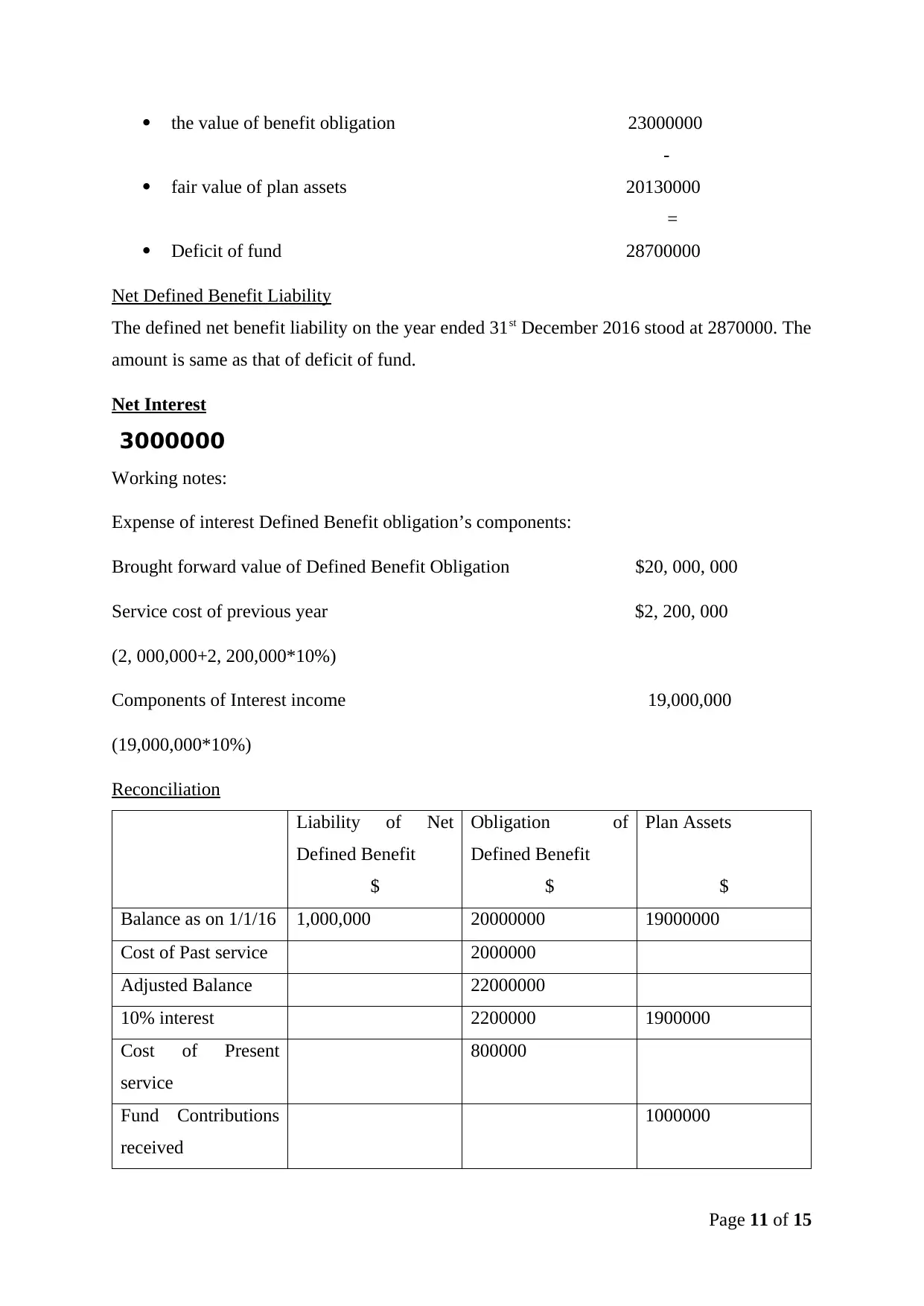
the value of benefit obligation 23000000
-
fair value of plan assets 20130000
=
Deficit of fund 28700000
Net Defined Benefit Liability
The defined net benefit liability on the year ended 31st December 2016 stood at 2870000. The
amount is same as that of deficit of fund.
Net Interest
3000000
Working notes:
Expense of interest Defined Benefit obligation’s components:
Brought forward value of Defined Benefit Obligation $20, 000, 000
Service cost of previous year $2, 200, 000
(2, 000,000+2, 200,000*10%)
Components of Interest income 19,000,000
(19,000,000*10%)
Reconciliation
Liability of Net
Defined Benefit
$
Obligation of
Defined Benefit
$
Plan Assets
$
Balance as on 1/1/16 1,000,000 20000000 19000000
Cost of Past service 2000000
Adjusted Balance 22000000
10% interest 2200000 1900000
Cost of Present
service
800000
Fund Contributions
received
1000000
Page 11 of 15
-
fair value of plan assets 20130000
=
Deficit of fund 28700000
Net Defined Benefit Liability
The defined net benefit liability on the year ended 31st December 2016 stood at 2870000. The
amount is same as that of deficit of fund.
Net Interest
3000000
Working notes:
Expense of interest Defined Benefit obligation’s components:
Brought forward value of Defined Benefit Obligation $20, 000, 000
Service cost of previous year $2, 200, 000
(2, 000,000+2, 200,000*10%)
Components of Interest income 19,000,000
(19,000,000*10%)
Reconciliation
Liability of Net
Defined Benefit
$
Obligation of
Defined Benefit
$
Plan Assets
$
Balance as on 1/1/16 1,000,000 20000000 19000000
Cost of Past service 2000000
Adjusted Balance 22000000
10% interest 2200000 1900000
Cost of Present
service
800000
Fund Contributions
received
1000000
Page 11 of 15
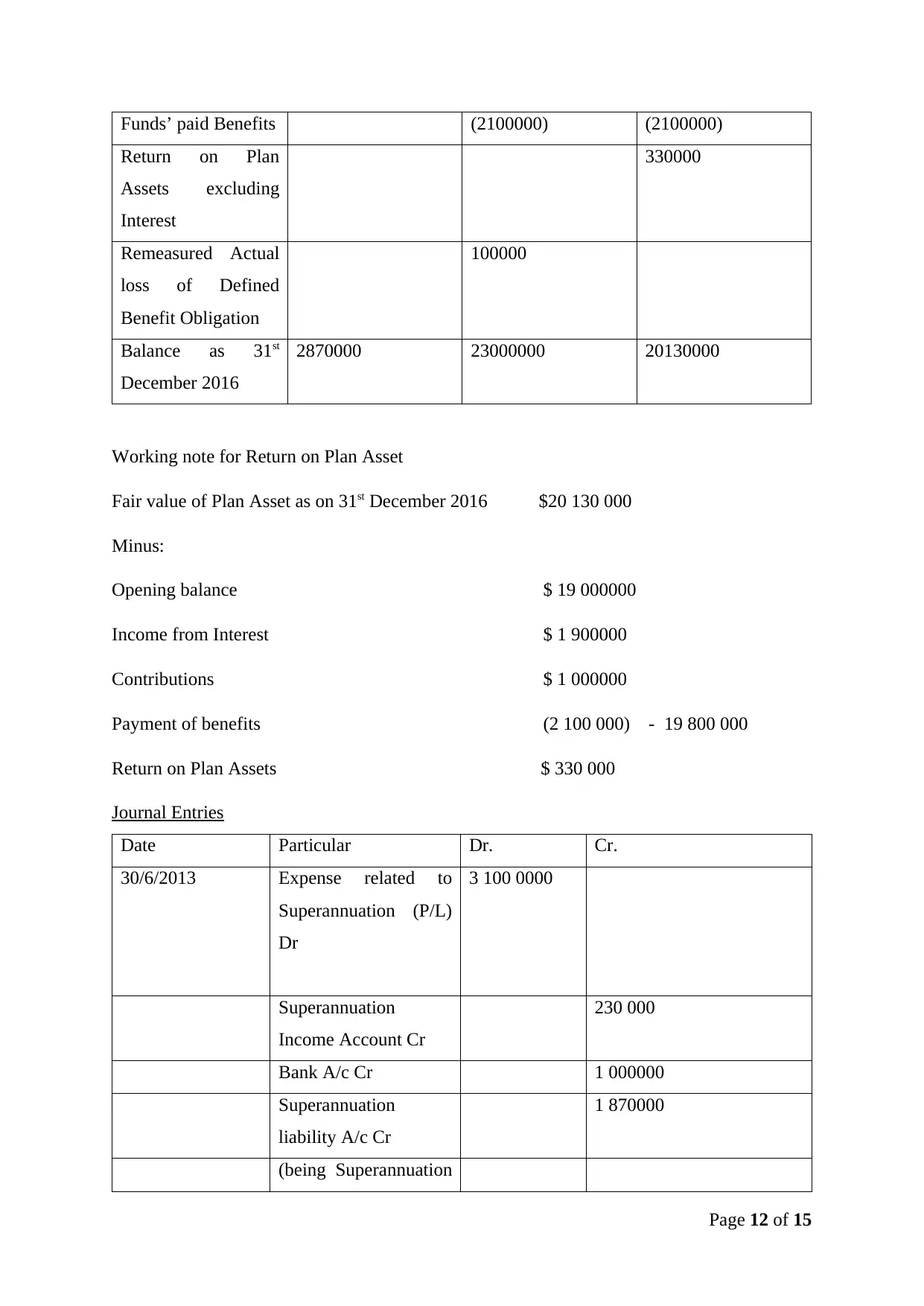
Funds’ paid Benefits (2100000) (2100000)
Return on Plan
Assets excluding
Interest
330000
Remeasured Actual
loss of Defined
Benefit Obligation
100000
Balance as 31st
December 2016
2870000 23000000 20130000
Working note for Return on Plan Asset
Fair value of Plan Asset as on 31st December 2016 $20 130 000
Minus:
Opening balance $ 19 000000
Income from Interest $ 1 900000
Contributions $ 1 000000
Payment of benefits (2 100 000) - 19 800 000
Return on Plan Assets $ 330 000
Journal Entries
Date Particular Dr. Cr.
30/6/2013 Expense related to
Superannuation (P/L)
Dr
3 100 0000
Superannuation
Income Account Cr
230 000
Bank A/c Cr 1 000000
Superannuation
liability A/c Cr
1 870000
(being Superannuation
Page 12 of 15
Return on Plan
Assets excluding
Interest
330000
Remeasured Actual
loss of Defined
Benefit Obligation
100000
Balance as 31st
December 2016
2870000 23000000 20130000
Working note for Return on Plan Asset
Fair value of Plan Asset as on 31st December 2016 $20 130 000
Minus:
Opening balance $ 19 000000
Income from Interest $ 1 900000
Contributions $ 1 000000
Payment of benefits (2 100 000) - 19 800 000
Return on Plan Assets $ 330 000
Journal Entries
Date Particular Dr. Cr.
30/6/2013 Expense related to
Superannuation (P/L)
Dr
3 100 0000
Superannuation
Income Account Cr
230 000
Bank A/c Cr 1 000000
Superannuation
liability A/c Cr
1 870000
(being Superannuation
Page 12 of 15
⊘ This is a preview!⊘
Do you want full access?
Subscribe today to unlock all pages.

Trusted by 1+ million students worldwide
1 out of 14
Related Documents
Your All-in-One AI-Powered Toolkit for Academic Success.
+13062052269
info@desklib.com
Available 24*7 on WhatsApp / Email
![[object Object]](/_next/static/media/star-bottom.7253800d.svg)
Unlock your academic potential
Copyright © 2020–2025 A2Z Services. All Rights Reserved. Developed and managed by ZUCOL.





